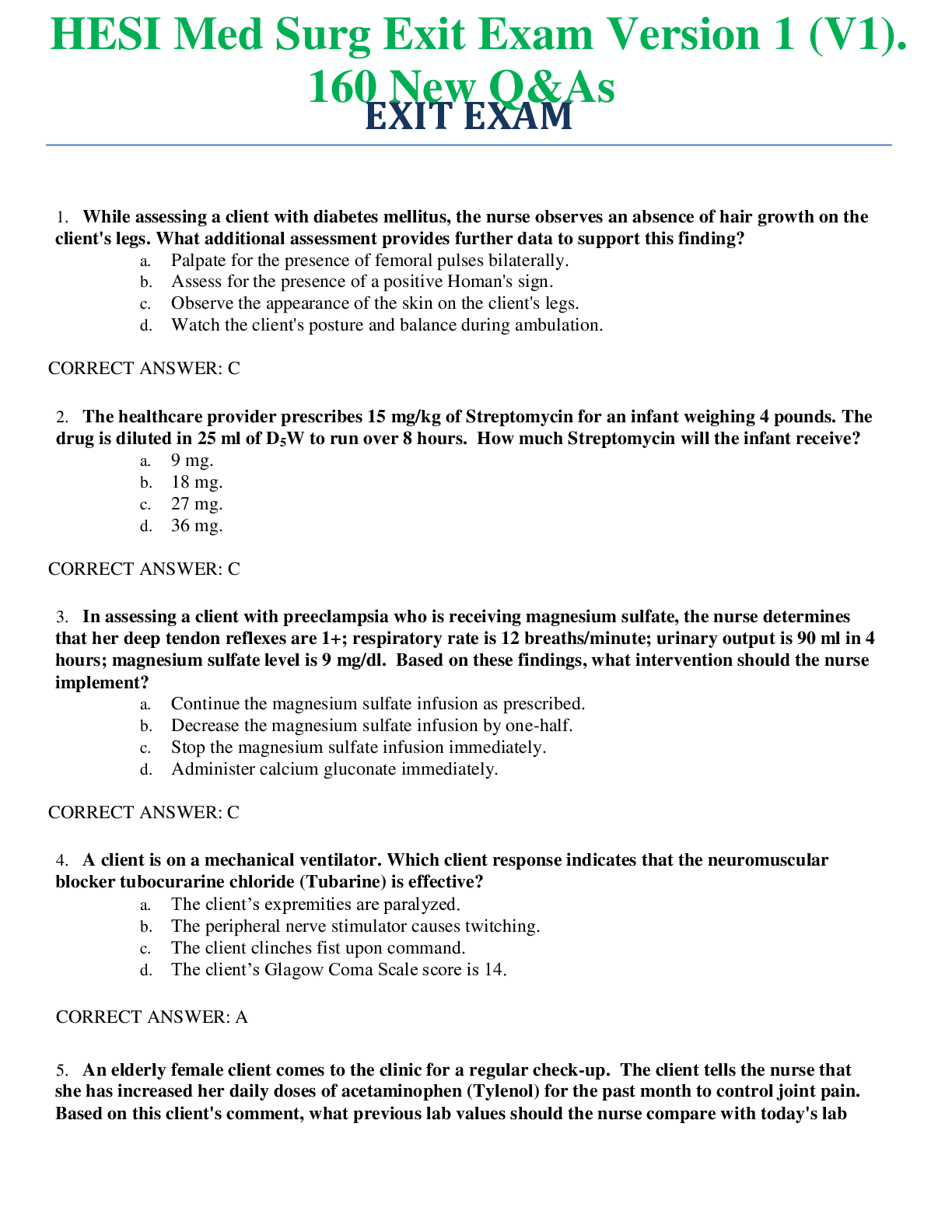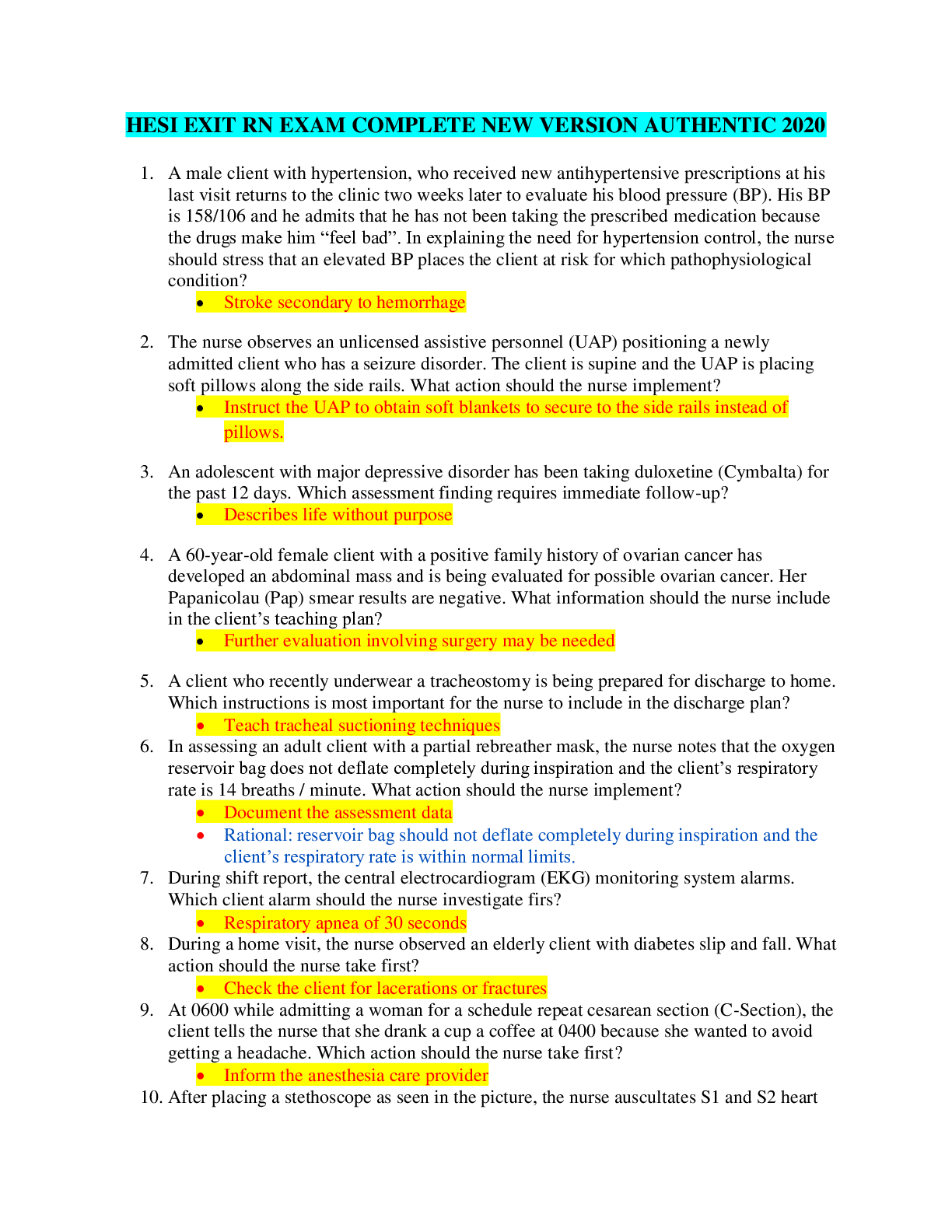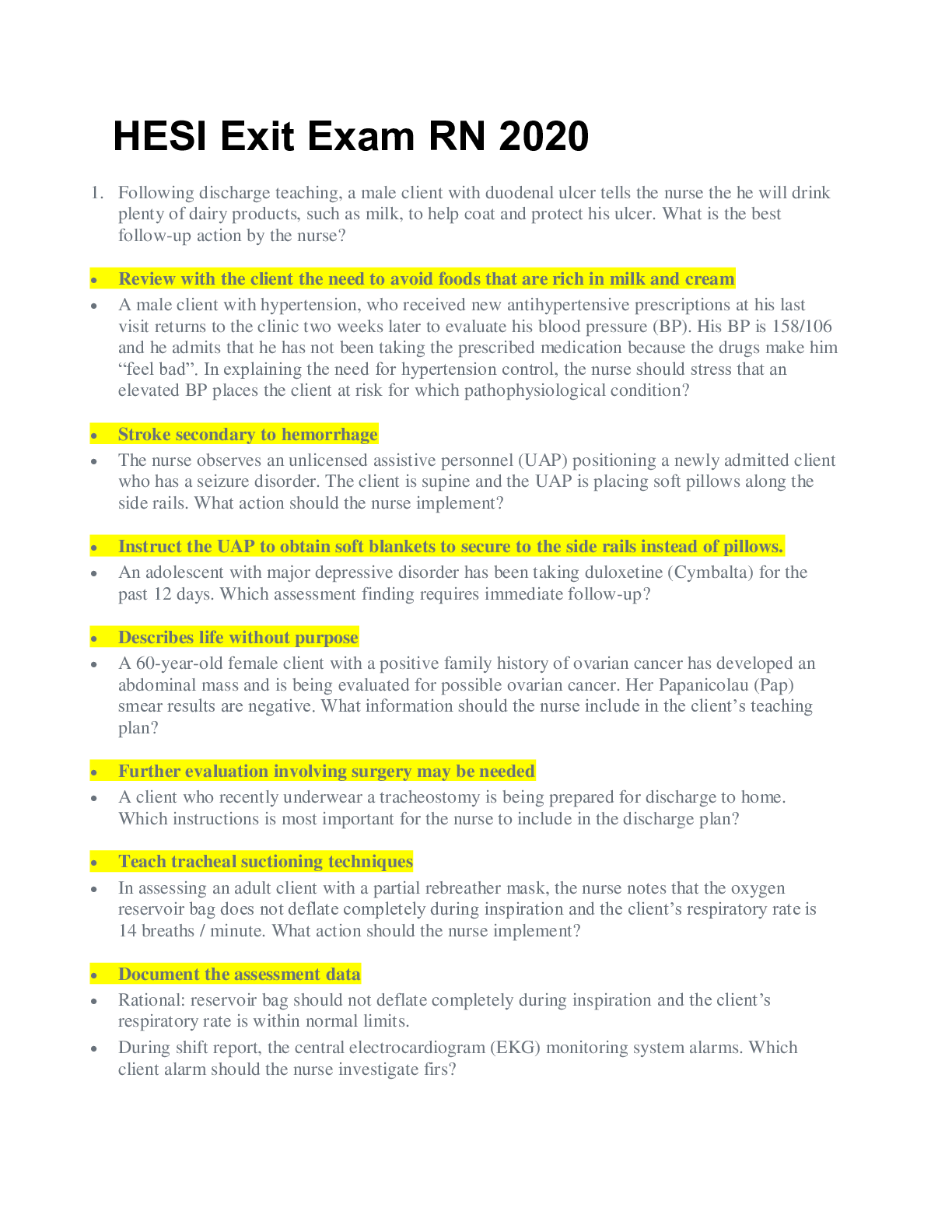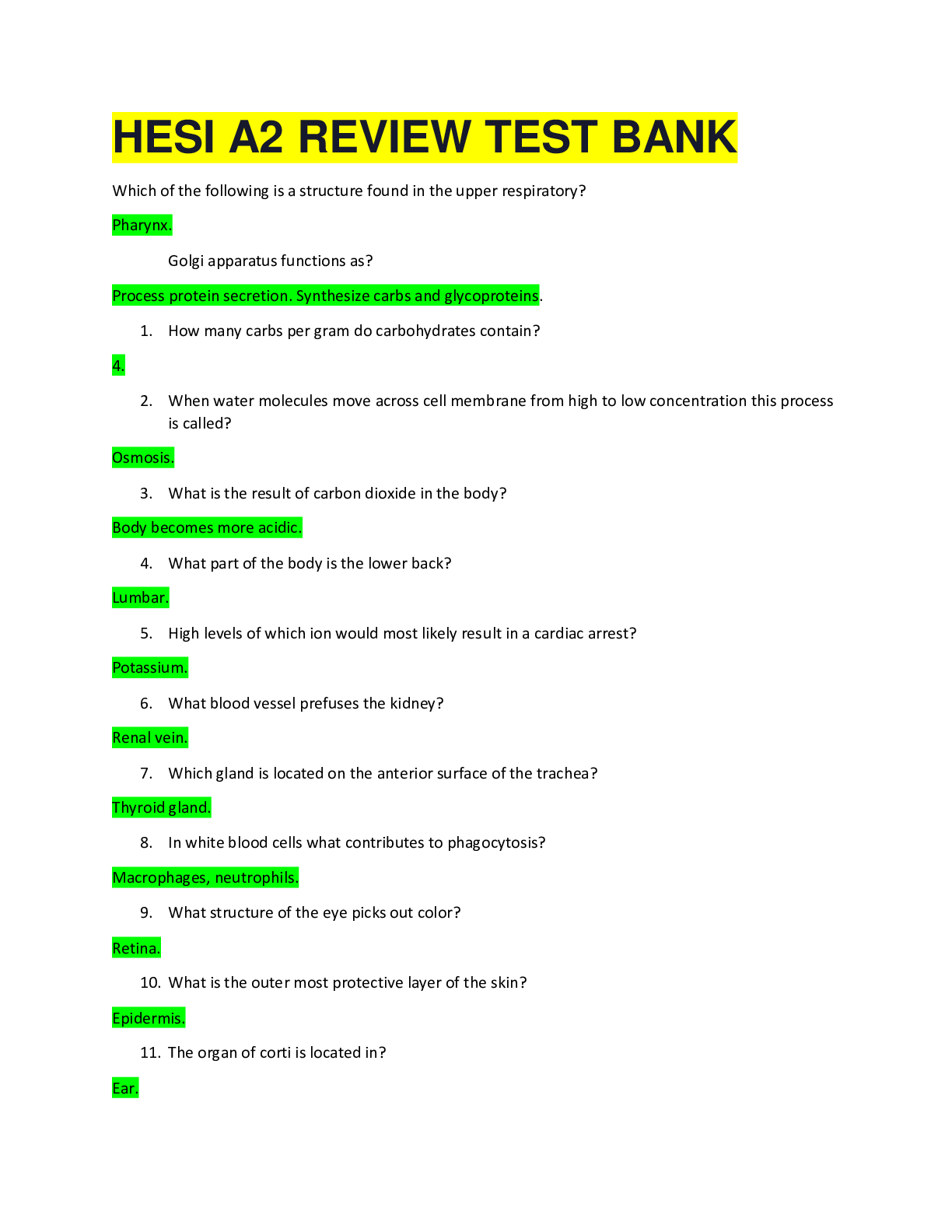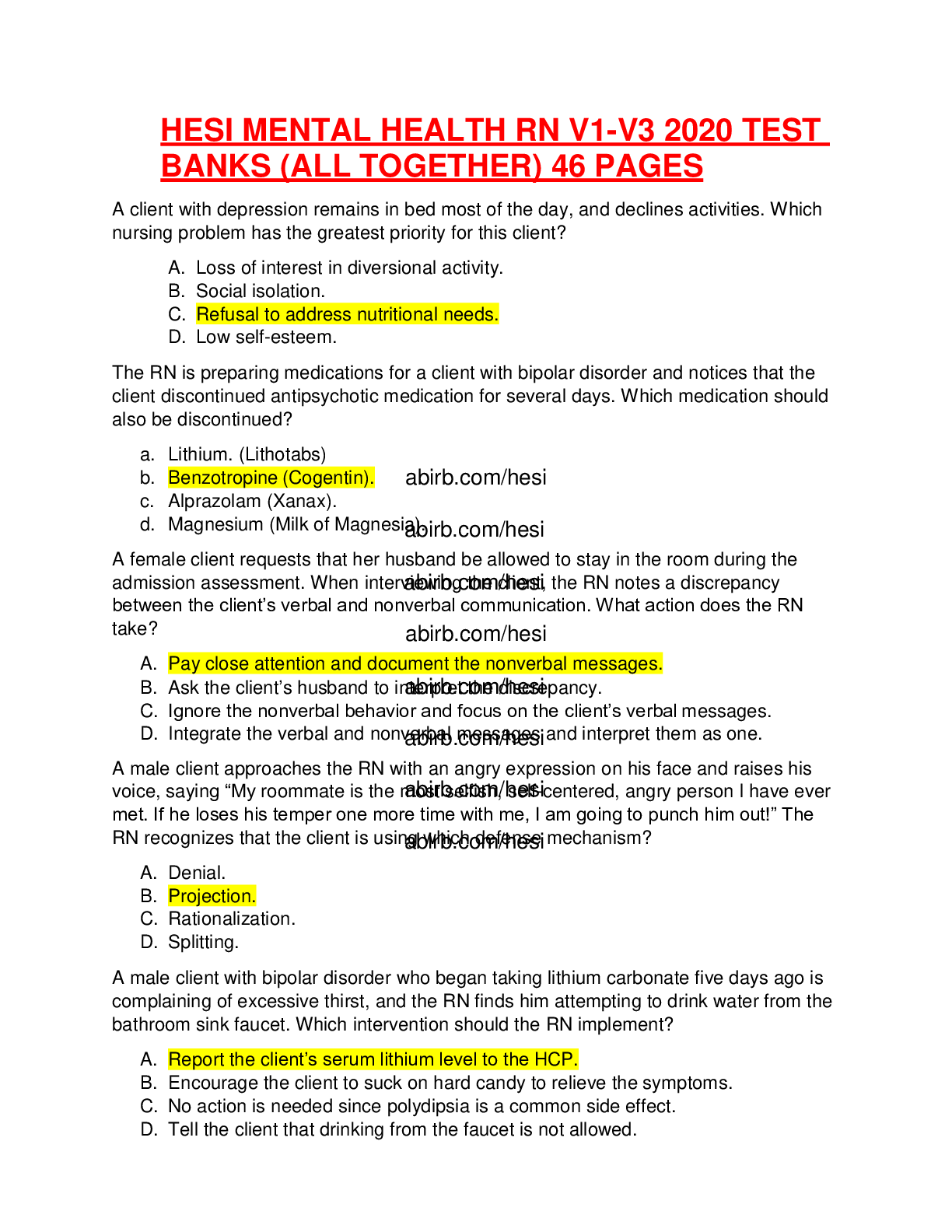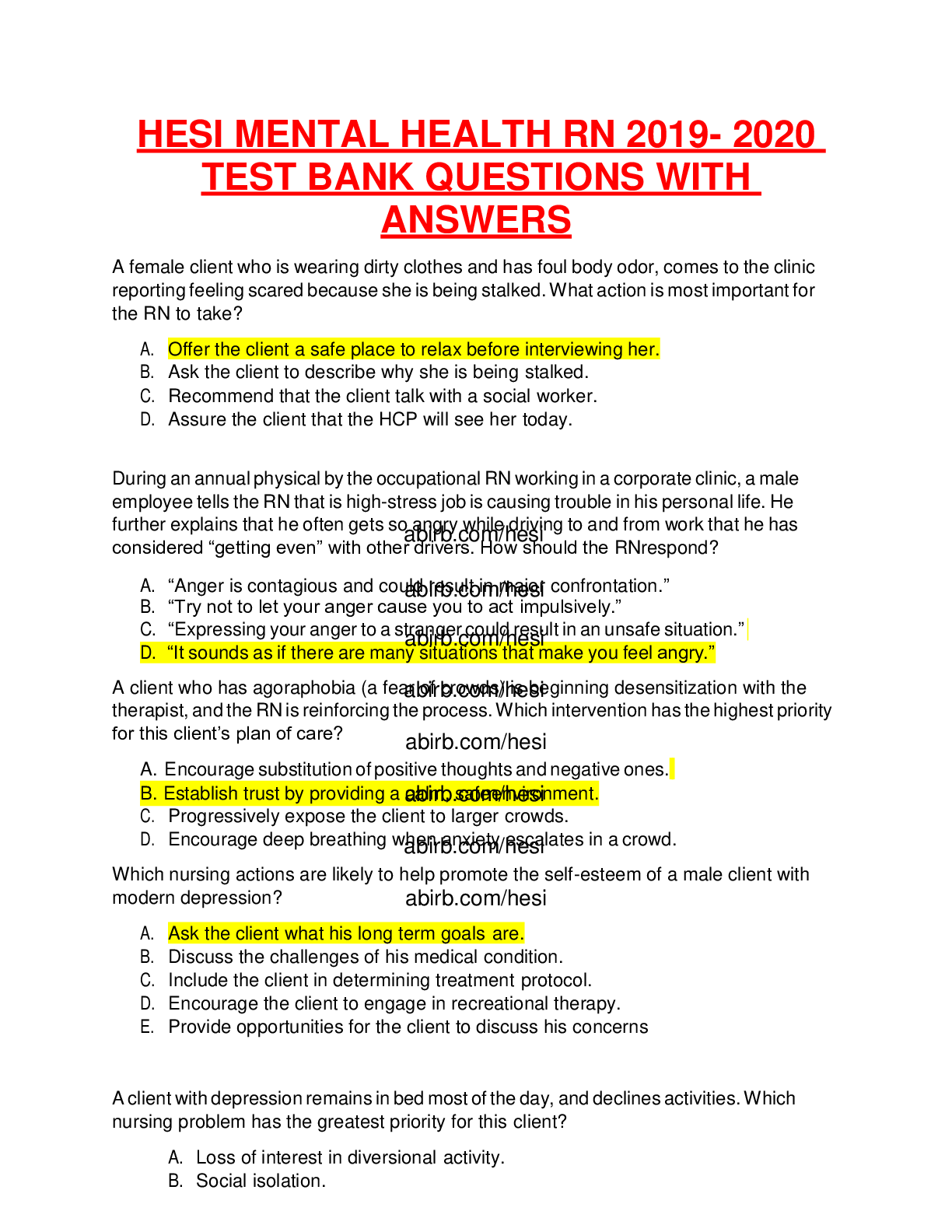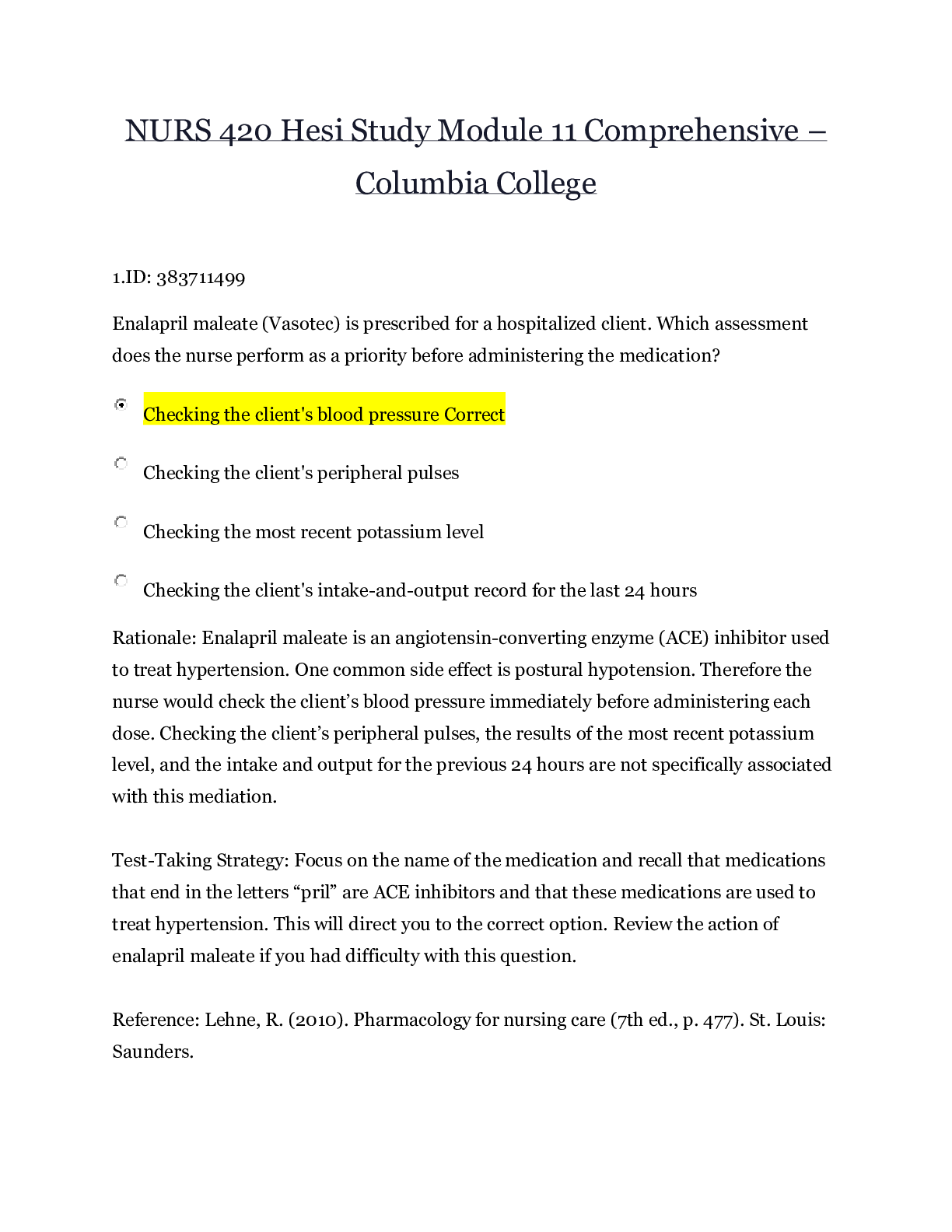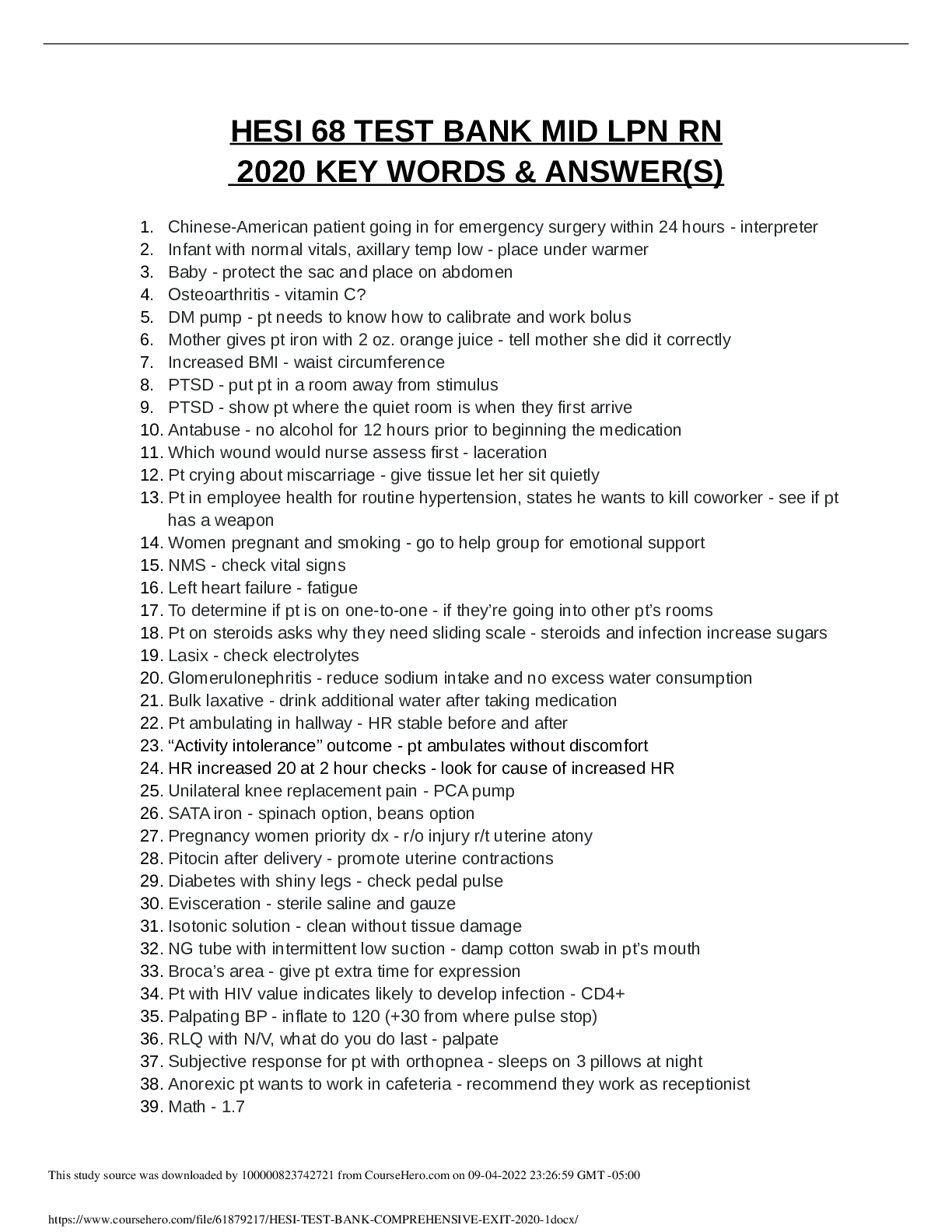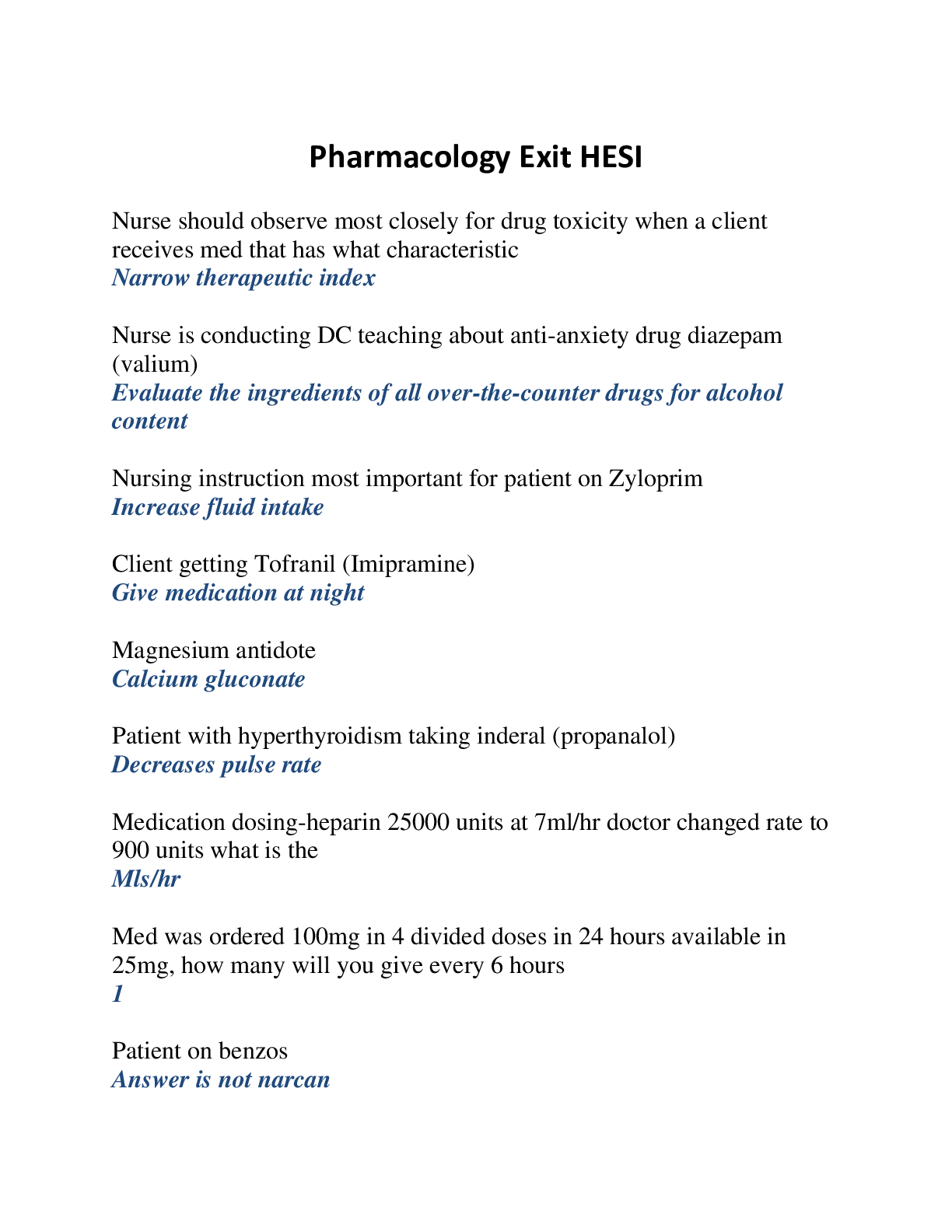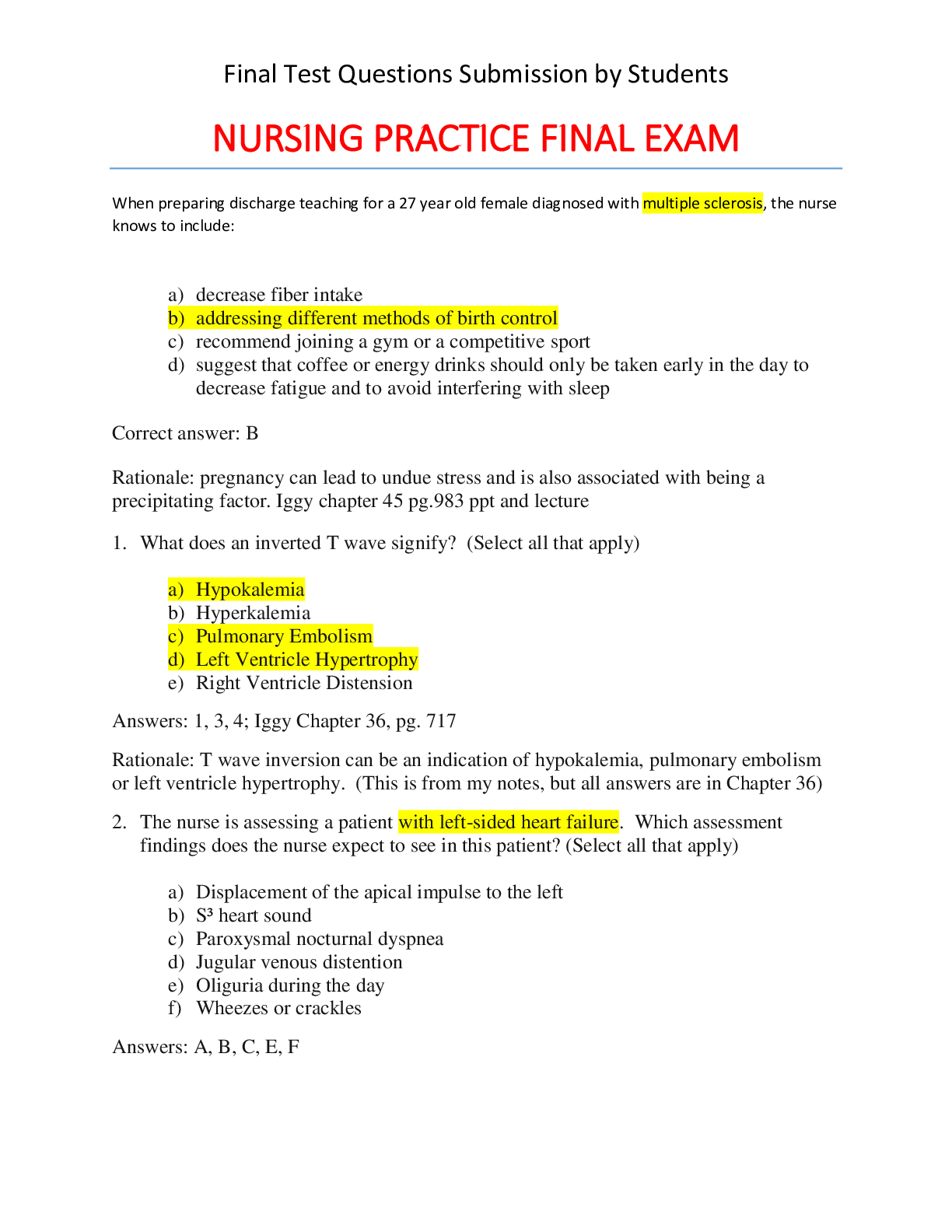OB HESI
Document Content and Description Below
OB Hesi 1. A primipara has delivered a stillborn fetus at 30-weeks’ gestation. To assess the parents in the grieving process which intervention is most important for the nurse to implement? A. exp... lain the possible cause of the fetal demise B. Provide an opportunity for the parents to hold their infant in privacy C. Encourage the parents to seek counseling within the next few weeks D. Assist the couple to request autopsy 2. A one day old neonate develops a cephalhematoma. The nurse should closely assess this neonate for which common complication? A. Jaundice B. Brain trauma C. Hypotension D. Osteomyelitis 3. What is the most important assessment for the nurse to conduct following the administration of epidural anesthesia to a client who is at 40 weeks gestation? A. Maternal blood pressure B. Level of pain sensation C. Station of presenting part D. Variability of fetal heart rate 4. The nurse is caring for a female client, a primigravida with preeclampsia. Findings include +2 proteinuria, BP 172/112 mmHg, facial and hand swelling, complaints of blurry vision and a severe frontal headache. Which medication should the nurse anticipate for this client? A. Clonidine hydrochloride B. Carbamazepine C. Furosemide D. Magnesium sulfate 5. A client at 35-weeks gestation complains of a "pain whenever the baby moves." On assessment, the nurse notes the client's temperature to be 101.2F, with severe abdominal or uterine tenderness on palpation. The nurse knows that these findings are indicative of what condition? A. Round ligament strain B. Chorioamnionitis C. Abruptio placenta D. Viral infection 6. While caring for a laboring client on continuous fetal monitoring, the nurse notes a fetal heart rate pattern that falls and rises abruptly with a “V” shaped appearance. What action should the nurse take first? A. Change the maternal position (please verify) B. Administer oxygen at 10/L by mask C. Prepare for a potential cesarean D. Allow the client to begin pushing 7. The parents of a newborn tell the nurse that their baby is already trying to walk. How should the nurse respond? A. Encourage the parents to report this to the healthcare provider B. Explain the newborns normal stepping reflex C. Acknowledge the parents observation D. Schedule the newborn for further neurological testing 8. What is the priority nursing assessment immediately following the birth of an infant with esophageal atresia and a tracheoesophageal (TE) fistula? A. body temperature B. level of pain C. Time of first void D. number of vessels in the cord 9. What is the most important assessment for the nurse to conduct following the administration of epidural anesthesia to a client who is at 40 weeks gestation? E. Maternal blood pressure F. Level of pain sensation G. Station of presenting part H. Variability of fetal heart rate 10. A 34 week primigravida woman with preeclampsia is receiving lactated ringers 500 ml with magnesium sulfate 20 grams at the rate of 3 grams/hours. How many ml/hour should the nurse program the infusion pump? 75 ml/hr 11. A 6-year-old with heart failure (HF) gained 2 pounds in the last 24 hours. Which intervention is the most important for the nurse to implement? A. Graph the daily weight for the past week B. Decrease IV flow rate C. Assess bilateral lung sounds D. Restrict intake of oral fluids 12. A mother of a 3-year-old boy has just given birth to a new baby girl. The little boy asks the nurse, "Why is my baby sister eating my mommy's breast?" How should the nurse respond? (Select all that apply) A. EXPLAIN THAT NEWBORNS GET MILK FROM THEIR MOTHERS IN THIS WAY B. REASSURE THE OLDER BROTHER THAT IT DOES NOT HURT HIS MOTHER C. REMIND HIM THAT HIS MOTHER BREASTFED HIM TOO D. Suggest that the baby can also drink from a bottle E. Clarify that breastfeeding is his mother’s choice 13. The nurse is examining an infant for possible cryptorchidism. Which exam technique should be used? A. Place the infant in the side-lying position to facilitate the exam B. Hold the penis and retract the foreskin gently C. Cleanse the penis with an antiseptic soaked pad D. PLACE THE INFANT IN A WARM ROOM AND USE A CALM APPROACH Cryptorchidism is the failure of one or both testes to descend normally through inguinal canal. For the infant’s comfort, the infant should be examined in a warm room with the examiner’s hands warmed. Testes can retract into the inguinal canal if the infant is upset or cold. Examining the infant with cold hands is uncomfortable for the infant and likely to cause the infant’s testes to retract into the inguinal canal. It may also cause the infant to be uncooperative during the examination. A rectal temperature yields no information about cryptorchidism. Testes can retract into the inguinal canal if the cremasteric reflex is elicited. This can lead to an incorrect diagnosis. 14. The nurse is planning care for a client at 30-weeks gestation who is experiencing preterm labor. What maternal prescription is most important in preventing this fetus from developing respiratory distress syndrome? A. BETAMETHASONE (CELESTON) 12 MG DEEP IM B. Butorphanol 1 mg IV push q2h PRN pain C. Ampicillin 1 Gram IV push q8h D. Terbutaline (Brethine) mg subcutaneously q15 minutes x3 15. Insulin therapy is initiated for a 12 year old child who is admitted with diabetic ketoacidosis (DKA). What action is most import for the nurse to include in the child’s plan of care? a. MONITOR SERUM GLUCOSE FOR ADJUSTMENT IN INFUSION RATE OF REGULAR INSULIN (NOVOLIN R) (PLEASE VERIFY) b. Determine the child’s compliance schedule for subcutaneous NPH insulin (Humulin N) c. Demonstrate to parents how to program an insulin pen for daily glucose regulation d. Consult with healthcare provider about use of insulin detemir (Levemir Flex Pen) 16. A 3 month old with myelomeningocele and atonic bladder is catheterized every 4 hours to prevent urinary retention. The home health nurse notes that the child has development episodes of sneezing, urticaria, watery eyes, and a rash in the diaper area. What action is most important for the nurse to take? a. Auscultate the lungs for respiratory pneumonia b. CHANGE TO LATEX FREE GLOVES WHEN HANDLING INFANT c. Draw blood to analyze for streptococcal infection (please verify) d. Apply zinc oxide to perineum with each diaper change [Show More]
Last updated: 2 years ago
Preview 1 out of 10 pages

Buy this document to get the full access instantly
Instant Download Access after purchase
Buy NowInstant download
We Accept:

Reviews( 0 )
$16.00
Can't find what you want? Try our AI powered Search
Document information
Connected school, study & course
About the document
Uploaded On
Mar 23, 2021
Number of pages
10
Written in
Additional information
This document has been written for:
Uploaded
Mar 23, 2021
Downloads
0
Views
129




